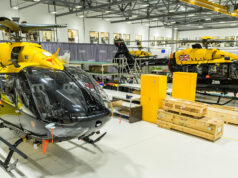The Royal Air Force’s new squadron of “network-enabled swarm drones” may not be ready by the end of 2019, despite Gavin Williamson’s claim that they will be.
In his speech, Williamson said “we expect to see these [drones] ready to be deployed by the end of this year”.
Many cast doubt on this claim early on, with Ulrike Franke, a fellow at the European Council on Foreign Relations, highlighting that drone programs historically take far longer to enter service.
So somehow I don't see Britain deploying "swarm squadrons of network enabled #drones capable of confusing and overwhelming enemy air defences" by the end of the year. But if Williamson proves me wrong, I'd be more than happy to write about this. (end)
— Ulrike Franke (@RikeFranke) February 11, 2019
When asked about the new drones, the MoD told us that “the details of who will build the drones, the tender process and the technology which will be employed, will be developed over the 3-year programme“.
The statement implies the programme is still in the very early stages, with the build plan and the technology the drone will use still yet to be decided. The statement also confirms it will be built under a tender process; a competition will be opened to industry partners to apply for the contract.
Some have even suggested therefore that 3 years is optimistic – there’s some doubt as to whether the technology for ‘networked swarming’ is currently ready.
Fundamentally therefore, “deployed by the end of this year” would appear to be deeply optimistic. But moreover, the MoD’s plan for the drones’ procurement directly conflicts Gavin Williamson’s plan.
The full response from the Ministry of Defence can be found below.
Question: Regarding the “swarm squadrons of network enabled drones” – who will these be built by?
- Will the process be completive?
- Is there existing technology or will JFC innovation be needed?
Answer: “The RAF will form a new squadron with a new concept, able to deploy swarms of network-enabled drones. The details of who will build the drones, the tender process and the technology which will be employed, will be developed over the 3-year programme”.














We should develop these drones ourselves, it is a great opportunity for exports.
I agree. Drones of various sizes should be a big opportunity for U.K. industry. We are world-class in the satellite industry which gives us world-class expertise in compact and resilient onboard control systems, we’re huge in formula 1 car manufacturing (world-class aerodynamics and materials science and other aspects of that sort of engineering) and then there’s our world-class engine manufacturers. Between that lot we’ve got most of it covered. Oh, and control/AI software plus cryptography for the secure data links as well.
I agree, we should also make an inexpensive reconnaissance drone version, I think there is a lot of demand on the World market for such a thing.
This part of today’s announcement is becoming intriguing. Have the MOD kept something up their sleeve which no one is aware of, planning to actually build a Taranis style larger drone, or will we be disappointed and get a dozen quadcopters from Toys r us? I’m still not sure, but could be exciting.
I just hope today is the start of something big, with further ambitious announcements made and backed by some extra funding. We are so close to being in a position of either regenerating or destroying both our ship building and aeronautical industries, it all comes down to the decisions made over the next couple of years.
Wouldn’t it be a better idea to mass produce hundreds of cheap small drones with a similar radar section of an F35. The drone needs to be cheaper than an S400 missile methinks!
The challenge is two fold, firstly how do you get enough fuel into a small cheap drone, to enable it to be launched from the range that is needed (100 miles plus) and how do you ensure that they cant just be jammed and therefore made useless. Ok cheap is a relative term in military terms but I assume they would need to be in the under £10k range to make them viable.
Range is of issue to drones, , smaller fuel capacity then full size aircraft.
Great news all round, dead impressed with Williamson’s complete reversal of MoD fortunes.
Shouldn’t this kind of news have been in the MDP instead of released all in one go at some innocuous conference?
Really liking Mr Williamson’s endeavour, will and drive in effecting change within the Forces and safety of our nation. He’s becoming a national treasure without the acknowledgement and limelight. Our strategy it seems is adapt once striked upon, the result,,, we learn, grow and strike back.
The future for our armed forces is to be at the forefront of electromagnetic technology, the foot prints we leave physically and electronically, to be always a step ahead of the enemy.
I personally feel security should be beefed up around the UK and particularly around places of real importance. The Chinese and Russians are forever testing us, we’ve become an easy target, that has to Stop!.
The reason this was not in the MDP is much the same reason our new bases were not in it. Williams is just making it up and the TOP brass are playing along. The UK has chosen to purchase foreign drones on three occasions. There is no secret drone program out there and there is no Budget to fund one. Williams talks about off the shelf purchase but there is no off the shelf option, even the US is only starting development of such things.
This is a grown adult man who keeps a spider in his room because he thinks it’s funny and openly talked last year of replacing the entire amphibious fleet with Car ferries. He’s making a bid for Tory leadership and he is copying the same approach as George Osborne of lying about everything just to get some big press release then never following through.
The UK should definitely have such a capability and it should be prepared to cut other programs to deliver it. Something like a squadron of ten Taranis derived deep penetrating UCAV’s armed with SPEAR 3 and Paveway IV bunker buster designed to engage an enemy airdefence operating amongst a swarm of MALD J drones. We could do that as well but it’s not going to be delivered in this time schedule and it will cost several billion atleast to get it off the ground.
I should say as well that MALD J is the only off the shelf option I can think that comes close to what he is talking about. Again it would be a very sensible purchase for the UK but it can hardly be described as a squadron of drones.
I think your on to something on with the MALD. Looking at the Wikipedia artical and the MOD expressed an interest to buy them a few years back, so this could just be the confirmation of that.
Not completely true. There has been a program running for the last ten years within the MOD science branch (Dstl) and Qinetiq with investigating and developing swarm technology. Granted this was initially used on “cheaper” quad style drones but has progressed up to controlling the fixed wing desert hawk flying as part of a large swarm. Yes, its very slow compared what is required, but it does prove the concept of providing mutual situational positioning and data sharing between the aircraft. This is one of the key areas of investigation, basically making sure that a swarm can fly together without crashing into each other when encountering turbulence for example. The current Desert hawk can be fitted with all manner of electro-optic and IR cameras, but can also be fitted with a synthetic aperture radar and a laser designator.
This mutual situational positioning technology could be very easily incorporated into the MALD airframe or the Reaper/Proetctor UAVs. The ADM-160 MALD was original developed as an aircraft launched decoy that could mimic the launch aircraft’s radar cross section and RF emissions so has a relatively short range. The newer versions do have a much longer range, but not the range we would expect for a strike package, unless they were carried by a mother aircraft. It is conceivable that the technology would be implemented with the Protector UAV, where two paired aircraft would not offer the persistence, but doubles the payload options for close air support. The technology could also be paired with either the Tomahawk or Storm Shadow missiles.
But as the DS was talking about creating a new RAF Squadron, could he be alluding to a production version of Taranis, as its been seen flying around Oz recently? As much as the swarm technology could be fitted to missiles, once they have been fired they can’t be recovered and if they were fired from the ground wouldn’t they be part of the Army? Therefore, logically if its designed to keep up with a fast jet, this looks like a new UAV purchase as the Reaper/Protector family are too slow. Possibly……
We are already buying 20 Protectors, which is the long-range, heavier, faster version of the MQ-9 Reaper. They were announced under Cameron but won’t be delivered until something like 2023. They have a SEAD capability, which should mean they are able to penetrate enemy air defences and destroy S400s and the like.
AFAIK, this is the only western UCAV that can currently/potentially do so. Smaller, slower drones would be shot out of the sky the moment they got inside enemy radar range and, even if some weren’t, their weapons payload is too limited to do serious damage.
I thought the Predator order must be what Williamson was talking about, recycling old news again. They are at the sophisticated end but are not network-enabled yet AFAIK i.e. they could not be flown in advance of an F-35 acting as a mother ship to suppress enemy air defences. I wonder how a smaller, cheaper UAV is going to do the job if the Predator can’t, or why we would want a second attack UCAV when we are just getting Predator, so puzzled by what (if anything!) Williamson has in mind.
Israel use cheap drones precisely to be targeted and shot down by enemy radar, thus giving away their position. The radar sites are then targeted with stand off missiles from F16’s etc. For that reason I see a good purpose of cheap UAV’s
For ‘Predator’ in 3rd para, read ‘Protector’
Could be a point, if the Predators are being replaced with Protector, could they be reusing the Predator airframes and adding in a networked capability?
T.S I’m thinking that too.
I just can’t get my head round what’s being proposed here. Reading through the news articles on it, some are saying they are to partner our F35’s which would mean a drone capable of range speed and agility to match, which surely prescribes something akin to Tempest. But the stated budget is £8 million, which will mean cheap and small, but how would they integrate with a strike fighter?
Sorry, Taranis not Tempest lol.
Coincidence?
https://www.flightglobal.com/news/articles/kratos-working-on-new-tactical-and-isr-drone-455675/
Protector is just a longer range version of reaper which is a bigger predator. All three are big slow propellor planes and would be slaughtered by even a basic air defence much less S400. Williams is pitching something very like DARPA’s Gremlins drones which is only at study phase at the moment.
Taranis is still technically in the joint Anglo French UCAV study and a decade away from any kind of development, it does not sound like what is being proposed.
The MOD was interested in MALD V which was a modular version of MALD that was cancelled however the new MALD system is basically the modular system the MOD was interested in.
My two penneth…
The term swarm suggests numbers. It also suggests small in size.
I imagine large numbers of affordable drones with an increased RCS to light up enemy air defence radars and saturate them with information to confuse the tactical picture. This should allow F35 with its lower RCS to potentially slip through the net more easily and carry out first strikes etc… I do not expect at all for these drones to be armed. More of a sacrificial lamb.
The price should be low enough to allow the expectation and intention to lose numbers to deplete SAM missile stocks. Price wise think the cost of current AD missiles etc… this is still sustainable at around the £100k per drone mark – think 10 drones accompanying one F35… even if all 10 drones are defeated as long as the F35 is able to strike its target that’s still only around the same cost of 1 single TLAM but with the ability to also gather data to share between other F35s with their own drone swarms… The intelligence gathering would be significant.
Based on that – the timeline doesn’t seem so far fetched? The only issue I see is the drone speed needs to match F35 or the tracking data from EADs will easily tell the difference… Maybe the drones could be single use none return and rocket powered… with some kind of terminal kinetic hardkill should the need arise… even a ‘dummy’ missile (think drone) striking an S400 unit would cause mission kill.
I welcome your opinions on this…
You have basically described the latest MALD capability other than the supersonic speed. They start at US$ 70,000 each but the jamming capability and sensors can go up to several hundred thousand.
Didn’t know about this program! Makes total sense – what DW has suggested must be in this vein surely?
https://www.google.com/amp/amp.timeinc.net/thedrive/the-war-zone/23126/recent-mald-x-advanced-air-launched-decoy-test-is-a-much-bigger-deal-than-it-sounds-like%3Fsource%3Ddam
Great, this looks to be it then. We should buy these off the shelf and learn from them, then build these capabilities into our own Spear 3 missile and have something we can export.
Drone speeds might not need to match the F35s. They could be sent out ahead in advance and the F35 catches up with them as they’re playing decoy for enemy air defences. They slip through as the cheap drones occupy enemy radar and missiles.
Once that networking and control is perfected then it can be applied to faster, more powerful UCAVs like Taranis.
My thoughts entirely. I think the first iteration of this will be quite simple, more a text programme and something more capable developed based on a couple years of experience at the squadron level GW refers to. This is going to have to develop through trial and error and committing to a very sophisticated solution now would almost certainly prove to be a dead end with bins full of wasted cash at the end.
Reminds me of the 1957 white paper.
cruise missile that releases hundreds of small battery powered drones inflight that emit RF or heat/IR signals to overwhelm radars and AD missiles would be the easiest cheapest solution, wouldn’t need to have specific targeting data just disperse over a wide enough area to cause confusion while the real firepower finds a target
More info from Janes.
https://www.janes.com/article/86286/uk-to-use-swarming-drones-to-defeat-enemy-air-defences
‘Israel use cheap drones precisely to be targeted and shot down by enemy radar, thus giving away their position. The radar sites are then targeted with stand off missiles from F16’s etc. For that reason I see a good purpose of cheap UAV’s’
Israel is operating on a pretty small battlefield, flying drones to Damascus, Lebanon, Sinai etc is like flying from London to Birmingham or, at a stretch, Liverpool! Any low-cost, light drone can do that.
We are not in that position: the only likely target for a British/NATO swarm attack would be a sophisticated air defence system, which by definition means principally Russia, or Russian/Chinese SAMs sold to their allies. The key difference with Israel is range – our swarm would, even if forward-based, have to travel 500-600 miles to the western Russian missile sites, probably more to Iran, a lot more to targets in China. Small propeller UAVs can’t do that range.
The US, which leads the field in UAVs, deploys its Reapers and Protectors by C-17, it’s the only way they can get them within flying range of their targets – and that apparently includes UAVs stationed in Europe. I just cannot see a swarm of slow, vulnerable, cheap, unarmed drones causing anything but amusement at a S400 missile base, they would be seen on radar from launch and taken out by fighter jets or small calibre cannon as they approached the target, no need to waste a valuable missile on them.
Anyway, the concept seems to be 3 years away, which suggests GW is looking for headline-grabbing news rather than anything more substantial.
Having seen the Trouble the Kurds had shooting down simple slow ISIS drones with small arms fire I am not convinced of your confidence in the short term. Surely it’s why there is a rush in The US in particular to develop laser weapons on trucks to be a leg to deal with them. Surely these drones would be flying at medium to high level for the most part and I think they can cause an aweful lot of confusion and missile wastage no matter how sophisticated the defence system is on paper. It’s going to be cat and mouse with each taking leaps ahead but either way it’s another problem for defences to deal with while trying not reveal their location.
We in the UK have been developing swarm technology for the last twenty years. There are two main players Qinetiq and Dstl who have both being investigating how a swarm can fly with mutual spatial awareness and data sharing. They did use cheap quad copters to prove the technology and have since moved on using Desert Hawks. The desert hawk is a cheap fixed wing uav (small/slow) that can carry IR/EO cameras, synthetic aperture radar or a laser designator. The technology allows the “swarm” to be outfitted with a multiple arrangement of sensors that can either fly in close formation or can spread out to give a wider coverage. The technology allows the swarm to be aware of its location and the relative location of each member by using limited AI. The data is then data linked back to the handler.
Moving on the technology is scalable, so in theory could be fitted to Tomahawk or Storm Shadow. However, these are true fire and forget weapons. However, the DS was intimating that a new Squadron would be formed to manage these drones. So logically are we not looking at an asset that can self launch and then be recovered, so more of the loyal wing man size of UAV – Taranis sized.
The Israelis have been successfully using the Delilah which is very similar in operation to the MALD, it is a multi-use weapon that can be used as a precise air to ground missile, reconnaissance of highly protected targets, or as a RF re-broadcaster ie decoy.
The problem with both the MALD or Delilah is that they are carried as part of the strike package and thereby take up space for a weapon and are probably to big to fit in the bay of an F35. Once released they can’t be recovered to be reused.
The Taranis has been seen flying in Oz last November, this may be entirely separate from the DS’s statement, however, the Taranis is a mature design and would take very little to produce. The mutual awareness technology would be an easy fit as it will have an inertial platform and GPS, but would need the addition of proximity sensors.
The statement from the DS infers that the new squadron will operate a UAV. From the mission spec, Reaper/Protector does not meet the criteria as they are too slow to keep up with say a Typhoon or F35 on a strike mission. This infers a new UAV type – Taranis perhaps….
This is officially the first step of replacing manned fighter aircraft in the UK. It was muted since the early 50’s that manned combat aircraft days were numbered.
At present Qinetiq, BAE and Dstl have been investigating adding swarm technology to unmanned aircraft. This started off by controlling groups of simple quad copters, which led to the grouping together of Desert Hawks. Which is a small cheap hand launched fixed wing reconnaissance platform, that can carry either EO cameras, IR sensors, synthetic aperture radar or a laser designator. By combining a group of four or more allows the swarm package to use all these sensors to give a greater situational picture, Qinetiq have demonstrated this technology.
The next stage is obviously putting the technology into a larger package. In the States Lockheed Martin Skunk works have tied together a couple of X45s to give them a semi-autonomous capability. However, this project did not “publicly” develop any further. It was possibly shelved because it meant that projects like the F22 replacement or the continued development of the F35 was not required.
The use of aircraft launched drones has been used in combat by both the US and Israel over Syria, using the MALD and Delilah missiles. The Delilah has the capability to carry out precision strikes, or reconnaissance, act as a RF/IR jammer or mimic the RF signature of an aircraft. It is however a fire and forget weapon that can’t be reused once launched.
The intent from the DS statement is that a new RAF Squadron will be established to run unmanned aircraft that can be used as part of a swarm. This intimates that it will be an independent aircraft that can launch and recover on it own. If the aircraft is required to keep pace with a F35 or Typhoon doing a strike mission this rules out Reaper/Protector as they’re too slow. Therefore it will be a new aircraft type.
The Neuron/Taranis is supposed to be coming into service by 2030, although Taranis prototypes have been flying in Oz as recent as last November, does the bi-lateral agreement rule out this aircraft? There is a US aircraft that has been recently released for export to certain Allied Nations. This is the Kratos Valkyrie, which is a development of the unmanned aerial target aircraft. It is built around the use of swarm technology and can be fitted with multiple type of sensors, but has a relatively small weapons payload. However, this is a first step and will be used for development more than any other purpose. The most important aspect is how it will interact with manned aircraft and the base station. If it uses the same secure datalink as the F35, it can be used without satellite communication which will help its lack of detection, by daisy chaining data back to the controller. If it uses a standard link16 data link, this will make it quite detectable. The possibility in air to air combat should also not be excluded, as a pair operating with a F35/Typhoon will generate significant situational awareness, that could dominate an area.
There are significant changes afoot, if the intent of the DS statement come to fruition.
Davey, I think you (and others) are going in the wrong direction with the high end, expensive solutions, at least as far as any drone swarm initiative. SPEAR 3 is to all intents and purposes a drone that could replicate and perhaps exceed MALD capabilities and be efficiently air launched from F35B, Typhoon and perhaps other platforms in sufficient numbers to be characterized as a swarm.
SPEAR 3 uses the same jet engine as MALD allowing high sub-sonic speed down to loitering speed if desired, with a range in the many 100’s of kilometres. It has 2-way datalink for control. It has GSP/INS, radar and of course warhead in missile form. But for the role outlined, the warhead can be scaled back or eliminated in exchange for extra fuel and/or enhanced electronics warfare packages. This solution is a relatively affordable, disposable, first day of war capability to help degrade adversary air defenses, that leverages commonality across other UK weapon systems.
No need to support independent launch and recovery, with all that associated cost, for what might get shot out of the sky anyway by a much more expensive SAM missile fooled into thinking its targeting an F35B or Typhoon. There may even be the opportunity to reduce costs further by leveraging COTS solutions.
As to the new squadron, that’s likely to be a bunch of operators on the ground. If the UK has many 100’s of drones in the air at once then it can’t rely on a pilot to manage a complex and constantly changing pattern of attack that would be desired to simulate attacking aircraft.
Hi Glass Half Full, I do agree with your view, however I do believe we will be getting something more than a MALD/Delilah missile. As I said earlier the mutual spacial awareness and mutual datalinking can be easily integrated into a Tomahawk/Storm Shadow or SPEAR 3 airframe.
The Israelis have proved hove good the multi-function Delilah is. The air strikes against the Russian/Syrian Pantsir S1 is probably a very good example. The latest example showed the Pantsir launch at least two SAMs at the approaching missile, then suddenly veer off. This is indicative of some very serious jamming. The video feed then shows the missile had a clear run to the targeted Pantsir. The Delilah can be carried by both fixed wing and helicopters. It is quite large (300mm diameter) and is based on an earlier air to ground missile. It has the capability, depending on what “package” is fitted, of carrying multi-spectrum reconnaissance, precision strikes, multi-spectrum jamming and mimicking another aircraft. I don’t know if Delilah has the capability of being integrated within a swarm, as the Israelis are very tight lipped about their weapon systems. If we could add this capability along with the swarm technology to either Tomahawk, Storm Shadow or Spear 3 it will massively help a strike package. Does the RAF/FAA require this capability, damned right, it is another string to the bow and come a peer vs peer conflict will be desperately required.
I don’t believe there will be a dedicated Squadron that supports this type of missile though, as it will be classed as another weapon system controlled by the armourers. This is why I think the DS was intimating of a new type of UAV. The one UAV that has been published with swarm technology is the Kratos Valkyrie which is due to be delivered to the USAF in 2020. It has also been released for export to friendly partner Nations. Whether, there is another UAV waiting in the wings that has been developed by a skunk works is yet to be seen. The Lockheed Martin proved the technology 10 years ago with the X45 prototypes.
Interesting times ahead methinks.
Fascinating reading DaveyB. Thank you.
Perhaps we are discussing at least two solutions with different goals/capabilities? For example a SPEAR 3 based anti-IAD drone solution might be £250-500k per unit, controllable weapon/intelligence/decoy disposable solution.
Kratos Valkyrie is a controllable, reusable platform, that actually carries other weapons such as the Small Diameter Bomb or SPEAR 3 class munitions. So Valkyrie is several levels above SPEAR 3, MALD, Gray Wolf solutions in terms of mission capabilities with a commensurate price tag. Considering the specs we’ll be lucky to get Valkyrie for less than £2M per, based on the Mako UTAP-22 FlightGlobal data and other articles https://www.flightglobal.com/news/articles/kratos-mako-drone-approved-for-sale-to-foreign-mili-446822/
Both can be used in swarms, but Valkyrie could be approaching an order of cost higher on a one for one basis. So for UK use it comes down to how many would constitute a swarm sufficient to overwhelm adversary defenses, is it affordable and how we plan to use them. For example the goal with a SPEAR 3 class solution would be destruction by an S-300/400/500 missile and ideally identify where the launcher and the radar are located before being destroyed. Valkyrie is intended to be an attritable platform but you wouldn’t really want to use it like that at £2m per if lower cost solutions are just as effective and available in higher numbers.
In practice both might be used with the SPEAR 3 as detectors/decoys and the Valkerie prosecuting the attack, with the IAD unable to tell the difference between the two, or other manned platforms also present.
Time would appear to have confirmed the “Williamson talking bollocks” thesis.
US patents for anti-gravity ‘black triangle’ aircraft that have now been published lead me to think that the UK may well have been experimenting with this technology. Here’s a description of my own witnessed sighting.
https://www.theufochronicles.com/2009/06/my-ufo-experience-daylight-observation.html?m=1
This technology far surpasses that of conventional drones.